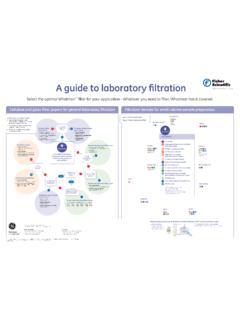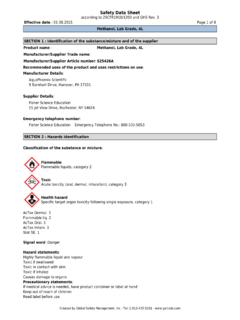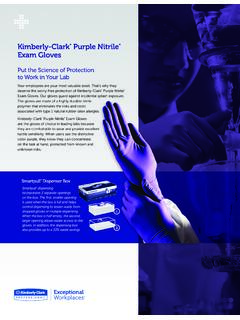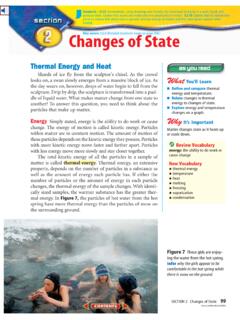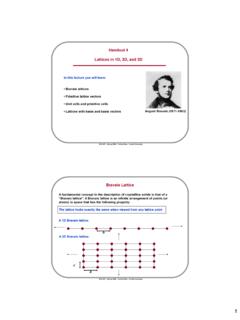Transcription of Safety Data Sheet - Fisher Scientific
1 Safety data Sheet according to 29 CFR1910/1200 and GHS Rev. 3. Effective date : Page 1 of 7. Calcium Nitrate, Tetrahydrate SECTION 1 : Identification of the substance/mixture and of the supplier Product name : Calcium Nitrate, Tetrahydrate Manufacturer/Supplier Trade name: Manufacturer/Supplier Article number: S25226A. Recommended uses of the product and uses restrictions on use: Manufacturer Details: AquaPhoenix Scientific 9 Barnhart Drive, Hanover, PA 17331. Supplier Details: Fisher Science Education 15 Jet View Drive, Rochester, NY 14624. Emergency telephone number: Fisher Science Education Emergency Telephone No.: 800-535-5053. SECTION 2 : Hazards identification Classification of the substance or mixture: Health hazard Specific target organ toxicity following single exposure, category 2. Specific target organ toxicity following repeated exposure, category 2. Oxidizing Oxidizing solids, category 3.
2 Hazards Not Otherwise Classified - Combustible Dust OxSolid 3. STOT Single Exposure 2. STOT Repeat Exposure 2. Signal word :Warning Hazard statements: May intensify fire; oxidizer May cause damage to organs May cause damage to organs through prolonged or repeated exposure Precautionary statements: If medical advice is needed, have product container or label at hand Keep out of reach of children Read label before use Do not eat, drink or smoke when using this product Keep away from heat/sparks/open flames/hot surfaces. No smoking Keep/Store away from clothing/../combustible materials Take any precaution to avoid mixing with combustibles Do not breathe dust/fume/gas/mist/vapours/spray Do not eat, drink or smoke when using this product Created by Global Safety Management, Inc. -Tel: 1-813-435-5161 - Safety data Sheet according to 29 CFR1910/1200 and GHS Rev. 3. Effective date : Page 2 of 7.
3 Calcium Nitrate, Tetrahydrate Wear protective gloves/protective clothing/eye protection/face protection Wash skin thoroughly after handling Get Medical advice/attention if you feel unwell IF exposed or you feel unwell: Call a POISON CENTER or doctor/physician In case of fire: Use agents recommended in section 5 for extinction Store locked up Dispose of contents and container as instructed in Section 13. Combustible Dust Hazard: : May form combustible dust concentrations in air (during processing). Other Non-GHS Classification: WHMIS. C D2A. NFPA/HMIS. NFPA SCALE (0-4) HMIS RATINGS (0-4). SECTION 3 : Composition/information on ingredients Ingredients: CAS 13477-34-4 Calcium nitrate tetrahydrate >99 %. Percentages are by weight SECTION 4 : First aid measures Description of first aid measures After inhalation: Loosen clothing as necessary and position individual in a comfortable exposed to fresh air.
4 Give artificial respiration if necessary. If breathing is difficult give medical assistance if cough or other symptoms appear. After skin contact: Rinse/flush exposed skin gently using soap and water for 15-20 medical advice if discomfort or irritation persists. After eye contact: Protect unexposed eye. Rinse/flush exposed eye(s) gently using water for 15-20 minutes. Remove contact lens(es) if able to do so during rinsing. Seek medical attention if irritation persists or if concerned. After swallowing: Rinse mouth thoroughly. Do not induce vomiting. Have exposed individual drink sips of water. Seek medical attention if irritation, discomfort or vomiting give anything by mouth to an Created by Global Safety Management, Inc. -Tel: 1-813-435-5161 - Safety data Sheet according to 29 CFR1910/1200 and GHS Rev. 3. Effective date : Page 3 of 7. Calcium Nitrate, Tetrahydrate unconscious person.
5 Most important symptoms and effects, both acute and delayed: Irritation, Nausea,Headache, Shortness of cause digestive tract disturbances. Irritation- all routes of exposure.;Ingestion of nitrate containing compounds can lead to methemoglobinemia, which is characterized by chocolate brown colored blood, headache, weakness, dizziness, breath shortness, cyanosis, rapid heart rate, unconsciousness and possible death Indication of any immediate medical attention and special treatment needed: If seeking medical attention, provide SDS document to should treat symptomatically. SECTION 5 : Firefighting measures Extinguishing media Suitable extinguishing agents: Use large quantities of water For Safety reasons unsuitable extinguishing agents: Dry chemicals, carbon dioxide, halon or foams Special hazards arising from the substance or mixture: Thermal decomposition can lead to release of irritating gases and oxidizer.
6 Contact with other material may cause a fire. May decompose explosively when heated or involved in a fire. Containers may explode when heated. May accelerate burning if involved in a fire. Advice for firefighters: Protective equipment: Use NIOSH-approved respiratory protection/breathing apparatus. Additional information (precautions): Move product containers away from fire or keep cool with water spray as a protective measure, where spark-proof tools and explosion-proof generating dust; fine dust dispersed in air in sufficient concentrations, and in the presence of an ignition source is a potential dust explosion inhaling gases, fumes, dust, mist, vapor, and contact with skin, eyes, and clothing. SECTION 6 : Accidental release measures Personal precautions, protective equipment and emergency procedures: Wear protective equipment. Use spark-proof tools and explosion-proof that air-handling systems are adequate ventilation.
7 Environmental precautions: Prevent from reaching drains, sewer or waterway. Collect contaminated soil for characterization per Section 13. Should not be released into environment. Methods and material for containment and cleaning up: Keep in suitable closed containers for protective eyeware, gloves, and clothing. Refer to Section obey local deposits should not be allowed to accumulate on surfaces, as these may form an explosive mixture if they are released into the atmosphere in sufficient concentration. Avoid dispersal of dust in the air ( , clearing dust surfaces with compressed air). Collect solids in powder form using vacuum with (HEPA filter). Evacuate personnel to safe areas. Reference to other sections: SECTION 7 : Handling and storage Precautions for safe handling: Minimize dust generation and accumulation. Follow good hygiene procedures when handling chemical materials.
8 Refer to Section contaminated materials. Do not eat, drink, smoke, or use personal products when handling chemical substances. Avoid contact with eyes, skin, and clothing. Conditions for safe storage, including any incompatibilities: Created by Global Safety Management, Inc. -Tel: 1-813-435-5161 - Safety data Sheet according to 29 CFR1910/1200 and GHS Rev. 3. Effective date : Page 4 of 7. Calcium Nitrate, Tetrahydrate Store away from incompatible from freezing and physical away from food and storage on wood floors. Do not store near combustible materials . Keep away from reducing agents. Provide ventilation for containers. Avoid storage near extreme heat, ignition sources or open flame. Store in cool, dry conditions in well sealed containers. Store with like hazards SECTION 8 : Exposure controls/personal protection Control Parameters: , , OSHA PEL TWA (Total Dust) 15 mg/m3 (50 mppcf*).
9 , , ACGIH TLV TWA (inhalable particles) 10 mg/m3. Appropriate Engineering controls: Emergency eye wash fountains and Safety showers should be available in the immediate vicinity of exhaust ventilation or other engineering controls to keep the airborne concentrations of vapor or dusts (total/respirable) below the applicable workplace exposure limits (Occupational Exposure Limits-OELs) indicated is recommended that all dust control equipment such as local exhaust ventilation and material transport systems involved in handling of this product contain explosion relief vents or an explosion suppression system or an oxygen deficient that dust-handling systems (such as exhaust ducts, dust collectors, vessels, and processing equipment) are designed in a manner to prevent the escape of dust into the work area ( , there is no leakage from the equipment).Use under a fume hood Respiratory protection: Not required under normal conditions of use.
10 Where risk assessment shows air-purifying respirators are appropriate use a full-face particle respirator type N100 (US) or type P3 (EN 143) respirator cartridges as a backup to engineering necessary use NIOSH approved breathing equipment. Protection of skin: Select glove material impermeable and resistant to the glove material based on rates of diffusion and of contaminated gloves after use in accordance with applicable laws and good laboratory proper glove removal technique without touching outer surface. Avoid skin contact with used protective clothing. Eye protection: Wear equipment for eye protection tested and approved under appropriate government standards such as NIOSH (US) or EN. 166(EU). Safety glasses or goggles are appropriate eye protection. General hygienic measures: Perform routine hands before breaks and at the end of contact with skin, eyes, and wearing wash contaminated clothing.




